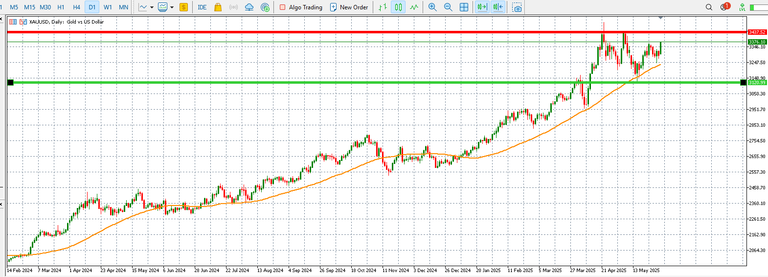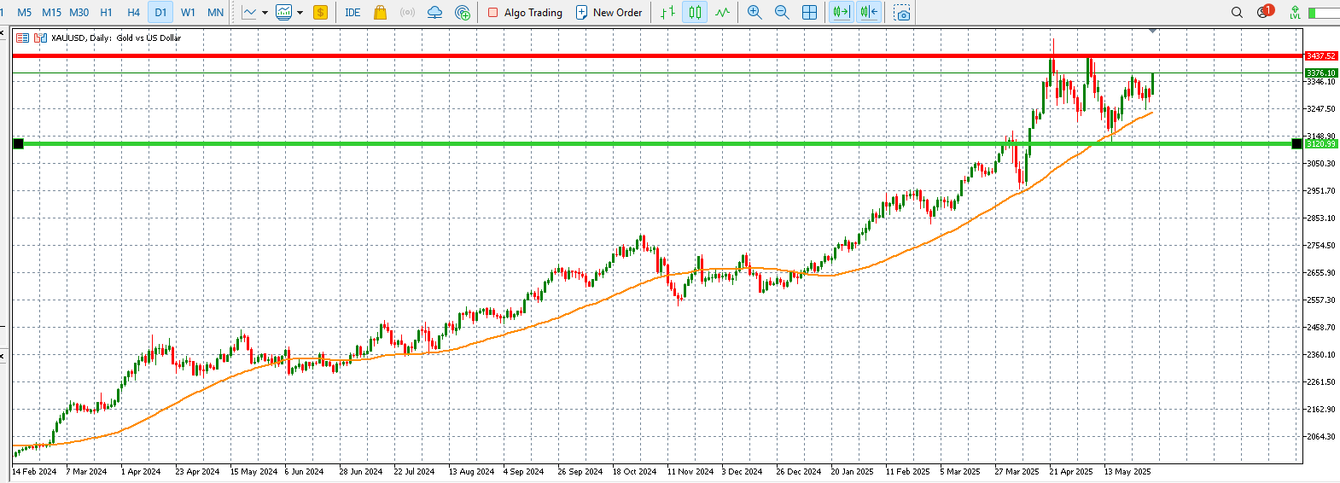Gold prices are on the rise once again as a cocktail of weak U.S. data and intensifying trade tensions revives investor appetite for safe-haven assets. The metal, often seen as a barometer of market anxiety, responded positively to the disappointing ISM manufacturing PMI data released on Monday. The reading came in at 48.5—below the forecast of 49.3 and slightly lower than April’s 48.7—underscoring the fragility of the U.S. industrial sector.
The sub-50 reading marks continued contraction in manufacturing activity and raises concerns that economic momentum in the U.S. is decelerating more rapidly than anticipated. For gold, which thrives in periods of uncertainty and economic stress, the data offered a compelling tailwind. Weak macro data tends to pull down Treasury yields and fuel expectations of easier monetary policy, both of which are traditionally supportive of gold prices.

Gold price: Chart by XTB
But the ISM numbers are only one part of the equation. The geopolitical and trade backdrop is equally critical—and arguably even more influential in the current market landscape. President Trump's decision to announce a sweeping new 50% tariff on steel imports has sent fresh shockwaves through global markets. Investors were already navigating a delicate economic environment, and this aggressive tariff move risks further inflaming tensions with major trade partners, particularly China.
Market participants are increasingly apprehensive that this new round of protectionism could stoke inflationary pressures while simultaneously weighing on global growth—a classic stagflationary setup. In such an environment, gold tends to outperform, acting as both a hedge against inflation and a refuge from equity market volatility.
U.S. equity markets, which wrapped up a strong May, have started June on more volatile footing. The tariff news has unsettled investor sentiment, dragging major indices lower and triggering a rotation into defensive assets. Gold, by contrast, is benefiting from its dual role as an inflation hedge and geopolitical risk shelter. ETF inflows into bullion-backed funds are rising again, a signal that institutional investors are seeking cover.
Tensions between the U.S. and China have also re-entered the spotlight. Despite recent attempts to stabilize the bilateral relationship, both sides are now accusing each other of failing to adhere to trade agreements discussed earlier this year. While this isn’t a new development, the rhetoric has become more charged in recent days, reviving memories of the prolonged trade war that rattled markets in 2018–2019.
Yet there is a flicker of optimism on the horizon. President Trump and Chinese President Xi Jinping are expected to speak this week, raising hopes that a dialogue at the highest level could pave the way for de-escalation. Traders are cautiously optimistic that some form of constructive engagement could emerge, particularly as both leaders face mounting domestic and international pressure to stabilise economic conditions.
Still, even the anticipation of high-level talks has not been enough to dent gold's appeal. The market appears unconvinced that any resolution will come quickly or painlessly. Instead, investors are pricing in a longer period of geopolitical risk, slower global growth, and policy uncertainty—all of which reinforce the bullish case for gold.
Traders view the current environment as structurally supportive for the yellow metal. Unless there is a dramatic reversal in U.S. economic momentum or a sudden thawing in trade tensions, gold is likely to retain its safe-haven bid in the weeks ahead. Traders should watch the upcoming Trump-Xi dialogue closely, as well as any further deterioration in macro data, particularly from the U.S. labour market later this week.
In summary, gold’s rebound reflects more than just one data point. It’s a confluence of softening economic fundamentals, resurgent trade tensions, and investor anxiety over the trajectory of both inflation and interest rates. Until the fog clears, gold will continue to serve as a reliable compass in a market clouded by uncertainty.
